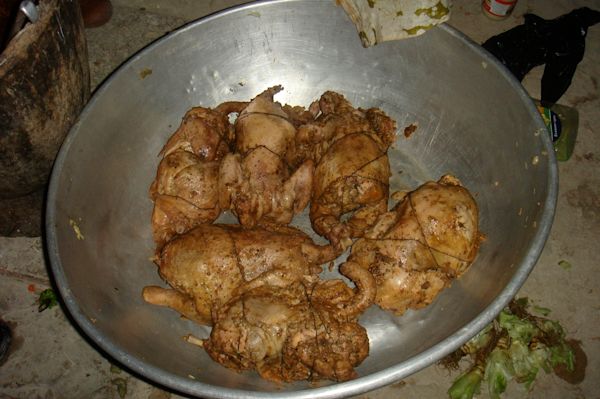Reading the Economic Chicken Bones
December 29, 2009
By Ilmari Soininen, KF9 in Thies, Senegal
Christmas kicks off a serious week of celebration for Senegal’s Christian minority. Dispersed families unite, meaning a series of sept-place, clando and bus rides from the capital. Like in many parts of the world, roasted chicken (or turkey) is an important part of the Christmas menu here. The bird is carefully prepared, and cooked to tender perfection. Chicken is not an everyday treat for most of Senegal. Indeed, it is quite a luxury item. But why is this so? And can this tell us something about the country’s future?
Chicken is expensive in Senegal. In fact, it’s really expensive: the average market price for a fresh chicken is almost $7, roughly twice what an American consumer pays. A back-of-the envelope calculation shows the average Senegalese must work a day and a half to be able to afford one, where as the average American needs to work only about 15 minutes. Indeed, chicken is one of the cheapest meats available to American consumers, where as in Senegal it is the most expensive.
Out of interest, I had conducted an informal poll among my colleagues and friends on the best invest opportunities available in Senegal. It was refreshing to hear investments which involved tangible and very real activities – not some esoteric derivative or CDO. Indeed, raising chickens was the most consistent answer. Again very different from the U.S. where chicken farmers will tell you it’s a tough business to make money in (excellent documentary Food Inc.). Indeed, the regional director of my MFI told me he would easily make triple his salary if he went full-time into the chicken business. Crunching the numbers reveals quite an amazing opportunity: starting out with 250,000 FCFA (about $500) in capital and a spare room or enclosure, one could invest in 200 chicks. The numbers:
- Each chick costs 450 FCFA, or 90,000 FCFA for 200.
- The feed for the six-week period is the most expensive part of the operation, costing around 150,000 FCFA.
- Additional costs, such as water, electricity and vaccinations are quite small, a maximum of 10,000 FCFA.
- After six weeks, one can expect to have about 190 chickens ready for market (calculating in a 5% mortality rate). One then has the option of selling directly to the customer, or selling to an intermediary at a lower price.
- If we sell directly to the customer, we can reasonably expect a price between 2,500 and 3,000 FCFA per head (or up to 3,500 FCFA in Dakar). With one’s 190 chickens, one can therefore expect a revenue between 475,000 and 570,000 FCFA, or a net income between 225,000 FCFA and 320,000 FCFA.
- Selling to an intermediary is easier and less time-consuming, but will reduce one’s income. Perhaps one will fetch only 1,800 FCFA per head, for a profit of 92,000 FCFA.
Of course, there are risks to consider: disease, hungry cats and theft are real concerns. An amateur can easily have his whole flock wiped out by bacteria he carries in on the sole of his shoe. However, managing a flock in the low hundreds is not rocket science, and the risks are by no means astronomical. Even as a secondary activity (selling to an intermediary) and keeping production at 200 chickens, one can have an annual profit margin of 200% with a minimal amount of time invested.
Economics 101 (aka common sense for the ostentatious) would suggest that such a profitable activity would soon be flooded with aspiring poultry entrepeneurs, causing the market price of chicken to drop dramatically. In economic jargon, with an increase in supply, the equilibrium price would adjust downward, along with the returns to the chicken farmer and vendor. However, the market price seems to stick around 2500 FCFA. Indeed, my colleagues told me demand is almost always greater than the supply.
So why aren’t people rushing into the poultry business if clearly there are large profits to be had? Is it that the average Senegalese simply doesn’t know about the profitability? Tough to believe, as everyone I talked with, from the day laborers to the senior bank management, knew it was very profitable. Is the barrier the inadequate access to investment capital? The chicken business (as the numbers show) doesn’t require a great deal of cash upfront and, thanks in large part to micro-finance, credit is available. I think the more critical barrier is a strong aversion to perceived risk. As one of my colleagues explained, a Senegalese graduate prefers a desk-job with a monthly salary to being in business for himself.
Whatever the reason, the worrying point is that these elephantine margins exists, especially given that this is by no means a secret. If the market does not adjust to clear signals, such as a profit margin of 200% – 500% in a sector which requires little capital investment, there is a critical economic dynamism missing. The global economy is ten fold fiercer with margins one hundred times smaller. In the global markets, economic opportunities aren’t served on a silver platter.
Fortunately, there are some who are responding to the tea leaves (or chicken bones). My colleague, Omar, a guard with my MFI, was financed yesterday for a 50,000 FCFA loan to buy a few dozen chicks.
/>PREVIOUS ARTICLE
Getting by with a little help from your friends →NEXT ARTICLE
How to be a Not-Microfinance Borrower →















